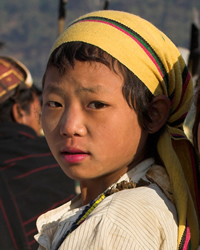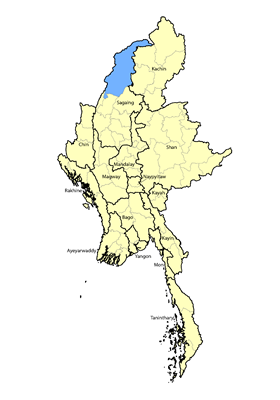Also known as “Hapaw,” the Haqpo are more than just a clan of Tangshang, as they view themselves as a distinct people group with their own history, customs, and language. Tired of generations of governments branding them “Nagas,” the leaders of dozens of small tribes and dialect groups formed their own alliance in 2003 and coined the new group name “Tangshang” by combining the names of two famous chiefs, Tangnyu Vang (Tang) and Shangnyu Vang (Shang).
Location: With just 300 people, the tiny Haqpo tribe is located near Pangsau in Lahe Township, which lies within western Myanmar's Sagaing Region. It sits at the foot of the Pangsau Pass, which forms the border with the Indian state of Arunachal Pradesh. One village inhabited by this group is called Naungsai, which had 16 households of Haqpo people in 2012. A visitor wrote: “Nanyun and Lahe townships are quite rugged. The first motorbike-accessible road through this area was just completed in 2010. Before that, travel was only possible on foot. Thus, many of these villages are remote and have little contact with groups beyond their closest neighbors.”
Language: A team of linguists visited Pangsau in 2012 and surveyed 105 Haqpo people, distributing questionnaires about their language and interviewing key members of the tribe. They concluded that, while Haqpo is markedly different from dozens of Tangshang languages and dialects spoken in Myanmar, it does show similarities in vocabulary and structure with four other tribes profiled in this book: Cyamkok, Cyampang, Lumnu, and Nahen.
The history of the Haqpo and other Tangshang tribes in Myanmar largely remains a mystery due to the British authorities refusing to acknowledge their existence during their 124-year rule of Burma from 1824 to 1948. Instead, “The British perceived that the best way to administer the territory was to perpetuate and extend the term ‘Naga' and to use linguistic and loose cultural affiliations to separate the peoples into so-called tribes…. Considerations overrode any form of political identification, while other villages speaking the same language were considered irrelevant.”
The Haqpo people are hard workers, with agriculture, fishing, and forestry being three of their main occupations. In the past, men needed to hunt to feed their families, but the number of wild animals has diminished in the Pangsau area in recent decades, leading to a more settled life for many Haqpo. Few villages in the township have roads leading to them, with the 2014 census finding that 16 percent of households in Lahe used either motorcycles or bullock carts as their primary mode of transportation, while the other 84 percent had no way of getting around except on foot.
Animism was not strictly viewed as a religion by its Tangshang adherents in the past. It was simply the accepted way of life and the worldview that countless generations of their forefathers had accepted, as they had no knowledge of God's creation and His working in the world. One mountain near Lahe was considered the abode of a powerful spirit, and the villagers dared not walk near it. In 1928, when British officer H. J. Mitchell “attempted to get the locals to clear a path to the summit, he was flatly refused any help from the villagers.”
Along with all other Tangshang groups in Lahe Township, the majority of Haqpo people are Christians, with a church hall central to their village life. Due to the absence of Scripture in a heart language they can understand, Burmese Bibles and songbooks are used in part of their services, but the Haqpo language is used for other activities including preaching, praying, announcements, and fellowship.
Scripture Prayers for the Haqpo in Myanmar (Burma).
| Profile Source: Asia Harvest |











